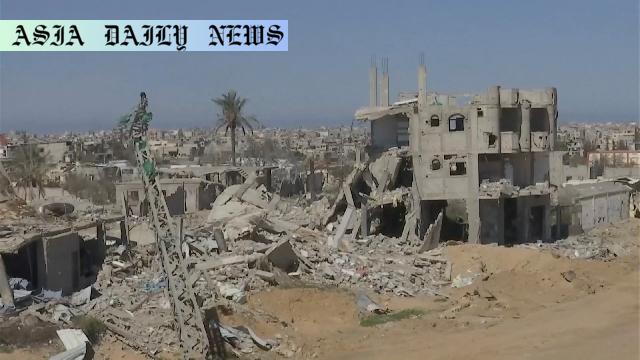Gaza Ceasefire – The fragile ceasefire is being tested as Israeli drone strikes continue, leaving behind destruction and casualties.
Israel’s drone strike in Gaza killed one person, injured several.
48,572 reported deaths since the escalation in October 2023.
Hamas and Israel are at odds over the second ceasefire phase.
Houthis in Yemen launched attacks on US forces in the Red Sea.

Sporadic Strikes Amid a Fragile Ceasefire
The ceasefire in Gaza, which aimed to bring a flicker of hope for peace, is on shaky ground as the Israeli military continues sporadic aerial strikes. These strikes come at a time when negotiations for the second phase of the ceasefire are ongoing but remain unfruitful. Local media highlighted these tense developments, reporting that one person lost their life while several others were wounded in an Israeli drone strike in central Gaza on Sunday. This comes as a grim addition to the tragedy of nine lives lost in northern Gaza just a day earlier. While ceasefire agreements are often seen as a step towards reconciliation, the continual violence raises serious doubts about meaningful progress.
A Devastating Human Toll
The scale of destruction and loss is unprecedented in Gaza. Health authorities reported an alarming death toll of 48,572 in the Strip since the onset of the conflict this October. The grim statistics serve as a reminder of the unrelenting suffering experienced by civilians, with thousands more injured or displaced. Each day of ongoing aggression adds to the already insurmountable challenges that humanitarian groups face in addressing the unfolding crisis. From the blockaded aid supplies to the ravaged infrastructure, Gaza’s people continue to endure unimaginable hardships. The ceasefire’s inability to bring civilian suffering to a halt underlines the need for international intervention and sustainable solutions.
International Reactions: Houthi Attacks in the Red Sea
The conflict’s ripple effects have not gone unnoticed, with repercussions extending beyond Gaza’s borders. The anti-government Houthi group in Yemen has reacted strongly, claiming responsibility for launching missile and drone attacks against a US aircraft carrier and other warships in the Red Sea. These strikes, termed as retaliatory, were in response to a US military operation that reportedly killed 31 individuals in Yemen’s capital of Sanaa. In escalating the crisis further, the Houthis have also declared their intent to mount attacks on Israeli vessels, citing Israel’s blockade on aid to Gaza as the trigger. This chain of events illustrates the interconnected nature of regional conflicts and the growing complexity of the Middle East crisis.
The Stalemate Over Ceasefire Terms
Central to the ongoing strife is the lack of consensus between Israel and Hamas over the terms of the second phase of the ceasefire agreement. Hamas demands a complete withdrawal of Israeli forces and an immediate cessation of further attacks. On the other hand, the Israeli leadership expresses concerns about long-term security and retaliatory measures by Hamas. This deadlock prolongs the suffering of civilians and delays the peace process. The international community has called for renewed diplomatic attempts, but such efforts remain hampered by deep mistrust between the two warring sides.
The Way Forward: Challenges and Prospects
Restoring peace in Gaza remains a monumental challenge, requiring not only a halt in hostilities but also addressing the underlying causes of the conflict. Any ceasefire agreement must be bolstered with guarantees of humanitarian aid, reconstruction efforts, and a sustainable political solution to ensure long-lasting stability. While diplomatic attempts are essential, grassroots initiatives to empower and support local communities hold equal importance. Amid all the devastation, the resilience of Gaza’s people serves as a beacon of hope, urging the global community to focus on recovery and lasting peace.
Commentary
The Human Cost of the Conflict
The ongoing crisis in Gaza profoundly reveals the fragility of humanity under conflict. That nearly 50,000 lives have been lost since October underscores the profound human cost of geopolitical disputes and the dire need to prioritize human life over political gains. Families in Gaza are not only losing loved ones but also their homes, livelihoods, and a sense of safety. For many, the ceasefire was a fleeting glimmer of hope, one that seems to fade with every sporadic airstrike and delayed agreement.
A Global Responsibility in a Local Conflict
While the Gaza ceasefire issue seems like a localized conflict, its implications are global. The rising tensions, retaliatory actions by groups such as the Houthis in Yemen, and the involvement of powerful nations like the US indicate that this crisis is more than a bilateral war. It underscores the interconnected nature of modern-day conflicts and the need for a collective resolution framework. As humanitarian aid remains blocked, the responsibility of the international community becomes even more significant in addressing not just Gaza’s immediate needs but also the geopolitical challenges that catalyze such conflicts.
Calls for Peace and Action
The situation in Gaza calls for not just reflection, but urgent and resolute action. Diplomatic talks need to become more than fragmented attempts at peace—they must be binding and inclusive of the needs of the civilian population. Advocacy for Gaza’s people should transcend politics, urging all stakeholders to prioritize peace and stability over prolonged aggression. As an observer, it is both disheartening and infuriating to see how the world often turns a blind eye to the suffering of the most vulnerable. The narrative must change, and the time to act is now.


